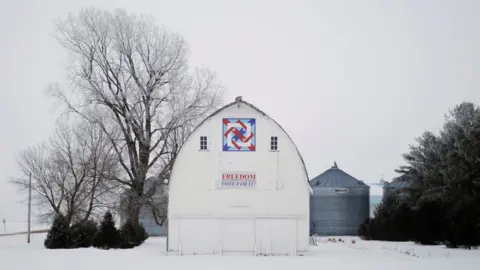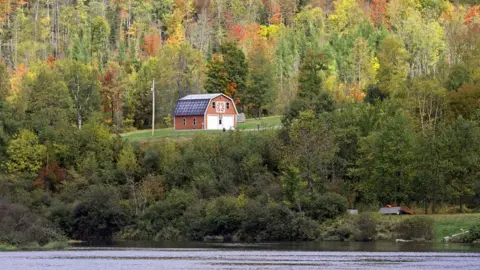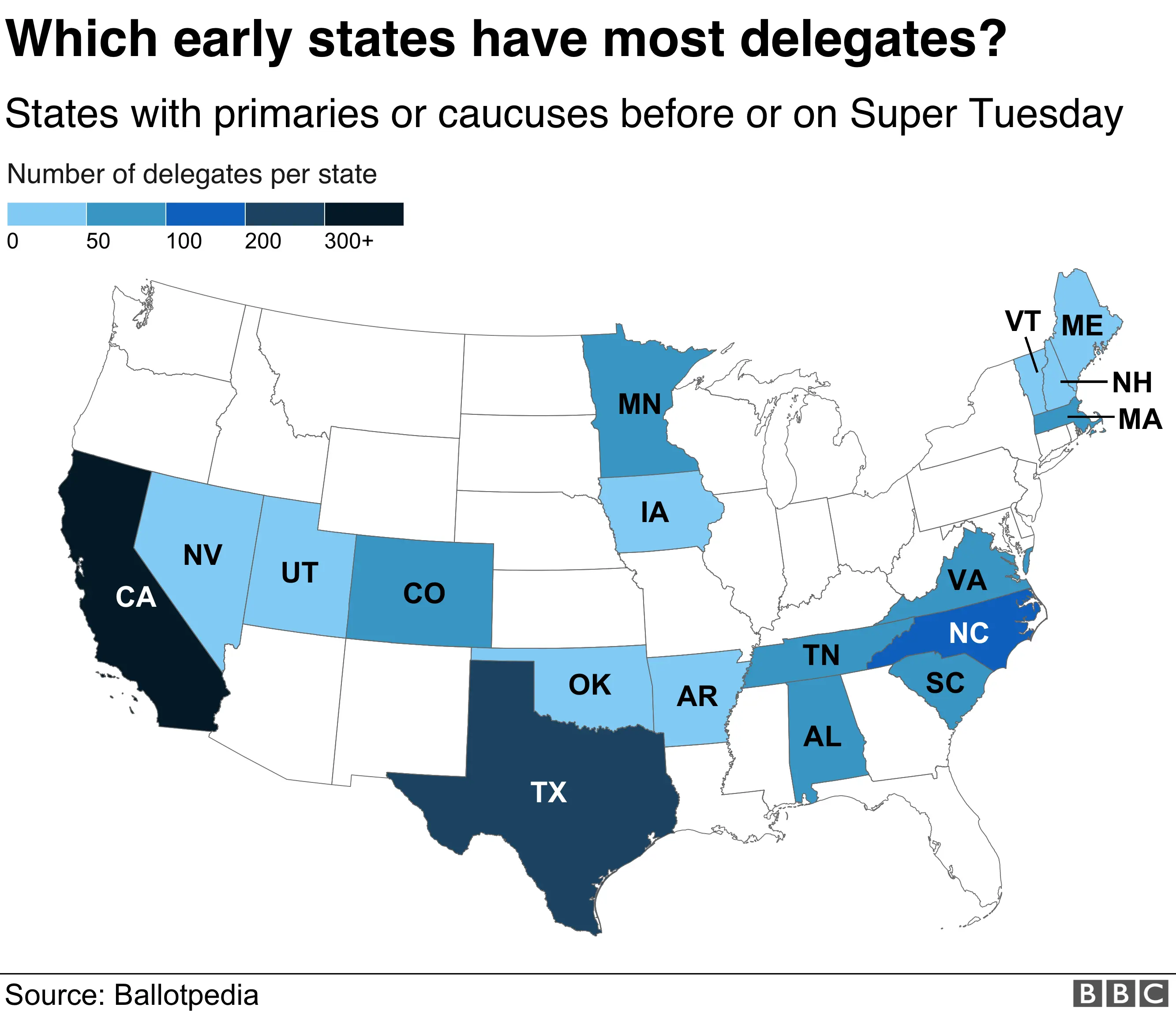US election 2020: What are primaries and caucuses and how do they work?
 Reuters
ReutersFour years after the world watched Donald Trump's momentum build and build until he became the Republican nominee, America is again deciding who will run for the White House.
The nominees are being chosen through a series of primaries and caucuses in every US state and territory, that began in Iowa on 3 February and ends in Puerto Rico in early June.
The Republican nominee will be Donald Trump. Even though technically he has a challenger, he is so popular among Republicans, he has a clear run ahead of him. With that in mind, the Democratic primaries are the only ones worth watching.
It's an unusual process, not all of which makes sense, although we've tried.
Step one: The start line
A whole year before the primaries, the first candidates emerged from hibernation. Over the year, others woke up and eventually 28 people announced they were running to become the Democratic nominee for president.
But dwindling funds, luke-warm or (ice-cold) public reaction and campaign infighting have, to varying degrees, led to most of them pulling out of the race.
At the start of primary season, 11 people remained in the running, a number that has now reduced to three. In theory, any one of them could become the nominee. In reality, only two now have a chance.
Step two: The Iowa caucuses
The first event of the primary season isn't a primary at all - it's a series of caucuses, in Iowa. These took place on Monday 3 February, in somewhat chaotic fashion.
What are caucuses?
A caucus involves people attending a meeting - maybe for a few hours - before they vote on their preferred candidate, perhaps via a head count or a show of hands. Those meetings might be in just a few select locations - you can't just turn up at a polling station.
As a result, caucuses tend to really suit candidates who are good at rousing their supporters to get out of bed. People like Bernie Sanders, for example, who performed well in Iowa this time, as did Pete Buttigieg.
Caucuses used to be far more popular back in the day, but this year, Democrats are holding only four in US states - in Nevada, North Dakota, Wyoming and Iowa.
If any candidate gets under 15% of the vote in any caucus, their supporters then get to pick a second choice from among the candidates who did get more than 15%, or they can just choose to sit out the second vote.
Why does Iowa matter?
A win there for any candidate can help give them momentum and propel them to victory in the primaries.
Why is Iowa first in the primary calendar? You can blame Jimmy Carter, sort of. Iowa became first in 1972, for various technical electoral reasons too boring to go into here. But when Carter ran for president in 1976, his team realised they could grab the momentum by campaigning early in Iowa. He won there, then surprisingly won the presidency, and Iowa's fate was sealed.
Why does Iowa not matter?
Iowa doesn't represent the entire US - it's largely white, so the way people vote there is very, very different than in other states.
Its record on picking the eventual nominees is a bit rubbish too, at least when it comes to Republicans - when there's an open Republican race, Iowa hasn't opted for the eventual nominee since 2000. Such names as Mike Huckabee, Rick Santorum and Ted Cruz have won there in recent years.
This year, Iowa suffered a bloody nose when the Democratic result was delayed by days due to technical glitches. Its curtain-raiser status may now be in doubt.
Step three: The New Hampshire primary
 Getty Images
Getty ImagesEight days after Iowa on Tuesday, 11 February, was the first primary, in New Hampshire. The tiny north-eastern state of only 1.3m people once again became an unlikely hotbed of political activity.
What is a primary?
Unlike a caucus, where voters are expected to turn up at a few limited locations at certain times and stick around for a while, primary voters can just turn up at a polling booth and vote in secret. Then leave.
How does a primary work?
The more votes a candidate gets in a caucus or primary, the more "delegates" they are awarded, and all candidates will be hoping to win an unbeatable majority of delegates.
The number of delegates differs in each state, and is decided by a convoluted series of criteria. In California's primary, for example, there are 415 Democratic delegates up for grabs this year. In New Hampshire, it was only 24.
This year is a bit different. Any candidate would need to get at least 15% of the vote in any primary or caucus to be awarded delegates. There are still eight candidates in the running - an unusually large number - so there's a risk the vote share will be spread out and some of the candidates may struggle to reach 15%.
After New Hampshire, we started to get a clear picture of who was struggling (Joe Biden, Elizabeth Warren), but even though Bernie Sanders and Pete Buttigieg had claimed the most delegates at this stage, neither is guaranteed to become the nominee.
The picture became much clearer on...
Step four: Super Tuesday
A few other states voted in between New Hampshire and the end of February, but things really started to warm up by Super Tuesday, on 3 March.
What is Super Tuesday?
THE big date in the primary calendar, when 16 states, territories or groups voted for their preferred candidate in primaries or caucuses. A third of all the delegates available in the entire primary season were up for grabs on Super Tuesday. By the end of the day it became much clearer that Joe Biden and Bernie Sanders were the front-runners for the Democratic nomination.

The two states with the most delegates voted on Super Tuesday - California (with 415 Democratic delegates) and Texas (228). California voted three months earlier than in 2016, making Super Tuesday even more super than normal.
Step five: The rest of the race
After hectic Super Tuesday, everyone gets to cool down for a week, before another busy day on Tuesday, 10 March, when six states vote, with 352 delegates available.
After that, the primary season still has three months left to run and at the end, the role of those delegates will become clear...
Step six: The conventions
 AFP
AFPDonald Trump will almost certainly be sworn in as the Republican nominee at the party convention in Charlotte, North Carolina, between 24 and 27 August. The Democrats will confirm their candidate at their own convention between 13 and 16 July in Milwaukee, Wisconsin.
What happens in a convention?
Here's where those delegates come in.
Let's say that during primary season, candidate A wins 10 delegates. During the convention, those 10 delegates would vote for candidate A to become the Democratic nominee. (Any party member can apply to be a delegate - they tend to be party activists or local political leaders.)
All through the Democratic primaries, there are 3,979 delegates available. If any one candidate wins more than 50% of those delegates during primary season (that's 1,990 delegates), then they become the nominee in a vote at the convention.
But if we get to the Democratic convention and no-one has more than 50% of the delegates, it becomes what's known as a "contested" or "brokered" convention. This could well happen this year. There are so many candidates that no one frontrunner emerges in the primaries, and they split the delegates between them. In that circumstance, a second vote would follow.
In that second vote, all the 3,979 delegates would vote again, except this time they would be joined by an estimated 771 "superdelegates". These are senior party officials past and present (former president Bill Clinton is one, as is current Vermont senator and presidential contender Bernie Sanders), and they're free to vote for whomever they wish.
If a candidate wins 50% or more in that vote - 2,376 delegates - then they become the nominee.
This is all thanks to a rule change in 2020: last time around, the superdelegates voted at the start of the convention, with the delegates. But many had pledged their support to Hillary Clinton even before the convention, leading her rival Mr Sanders to suggest the deck was stacked against him.
He's the one who campaigned for the change - and it may benefit him in 2020.
Step seven: The presidency?
After inching past Iowa, negotiated New Hampshire, survived Super Tuesday and come through the convention, there is only one step left for the nominee: the presidential election, on 3 November.
We'll explain how that one works a little closer to the time.

Full primary season calendar
(Primaries unless stated otherwise)
FEBRUARY
Monday 3
- Iowa caucuses (Democratic, Republican)
Tuesday 11
- New Hampshire (D,R)
Saturday 22
- Nevada (D)
Saturday 29:
- South Carolina (D)
MARCH
Tuesday 3 (Super Tuesday)
- Alabama (D, R)
- American Samoa caucuses (D)
- Arkansas (D, R)
- California (D, R)
- Colorado (D, R)
- Maine (D, R)
- Massachusetts (D, R)
- Minnesota (D, R)
- North Carolina (D, R)
- Oklahoma (D, R)
- Tennessee (D, R)
- Texas (D, R)
- Utah (D, R)
- Vermont (D, R)
- Virginia (D)
- Democrats Abroad (D)
Tuesday 10
- Idaho (D, R)
- Michigan (D, R)
- Mississippi (D, R)
- Missouri (D, R)
- North Dakota caucuses (D)
- Washington state (D, R)
Thursday, 12
- Virgin Islands caucuses (R)
Saturday 14
- Guam caucuses (R)
- Northern Marianas (D)
Tuesday 17
- Arizona (D)
- Florida (D, R)
- Illinois (D, R)
- Northern Marianas caucuses (R)
- Ohio (D, R)
Tuesday 24
- American Samoa caucuses (R)
- Georgia (D, R)
Sunday 29
- Puerto Rico (D)
APRIL
Saturday 4
- Alaska (D)
- Hawaii (D)
- Louisiana (D, R)
- Wyoming caucuses (D)
Tuesday 7
- Wisconsin (D)
Tuesday 28
- Connecticut (D, R)
- Delaware (D, R)
- Maryland (D, R)
- New York (D, R)
- Pennsylvania (D, R)
- Rhode Island (D, R)
MAY
Saturday 2
- Guam caucuses (D)
- Kansas (D)
Tuesday 5
- Indiana (D, R)
Tuesday 12
- Nebraska (D, R)
- West Virginia (D, R)
Tuesday 19
- Kentucky (D, R)
- Oregon (D, R)
JUNE
Tuesday 2
- District of Columbia (D, R)
- Montana (D, R)
- New Jersey (D, R)
- New Mexico (D, R)
- South Dakota (D, R)
Saturday 6
- Virgin Islands caucuses (D)
Sunday 7
- Puerto Rico (R)
